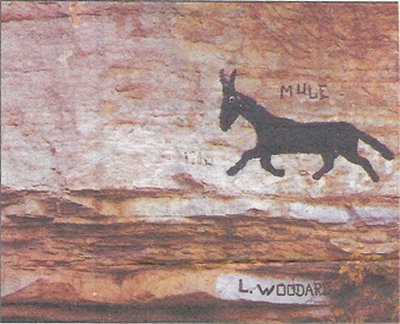The following was Published by The SMITHVILLE REVIEW, 11 November, 2006.
This is being used with the permission of The SMITHVILLE REVIEW.
Historian unravels Liberty Mule mystery.
By Thomas G. Webb,
DeKalb County Historian

- One of the best-known spots in DeKalb County is the Allen Bluff on Smith Fork, just west of Liberty. It is
also a spot that has aroused the curiosity of many people, who want to know why a black mule is painted there,
who painted it and how long ago.
- Just a few days ago I found what seems to be the authentic answer to all those questions. While looking for
an obituary in the 1957 issue of the Smithville Review, I saw in the March 7 issue an article written by Dr. Wayne
T. Robinson, who wrote several historical articles for the Review in the 1940s and 1950s. Dr. Robinson grew up
in the house at the foot of Snow’s Hill where Bobby Colvert now lives. He later lived in Dallas, Texas, but often
visited his mother, who lived to be 100.
- While in DeKalb County in 1956, he had returned to a cave, which he had been in 50 years earlier, and the article
he wrote was mainly about the cave and how little it had changed in 50 years. At the end of the article he wrote,
“In early October 1906, I climbed up the face of the Allen Bluff to a ledge and with some coal tar made a flat
picture of a character from a famous comic strip of that day. Everybody remembers Maude, the mule. That was 51
years ago, and even though it has been exposed to the elements and to nearby earth-shaking explosions, erosion
has dimmed it very little. On the same bluff is the name of Will T. Hale, which was inscribed about 85 years ago.”
- Dr, Robinson was born on April 10, 1885, so he was 21 years old when he did the painting, and was in college
at the time. Apparently, he did not tell people that he did the painting. After finishing medical school, he lived
in Shelbyville, Tennessee, until he moved to Dallas in 1923. Thus the name of the painter became a mystery to the
residents of Liberty, as well as the people passing through.
- In 1979 Elmer Hinton brought up the question of who painted the mule in his column in the Nashville Tennessean,
and on January 21, 1979, he had an answer. lawrence D. Williams of Shelbyville, a cousin of Wayne Robinson, said
that Dr. Robinson did the painting, he thought, about 1900. He also thought he did it to advertise the business
of Wayne’s father, Beverly Robinson, who was a mule trader.
- A second correction was in the Tennessean on February 25, 1979, and it came from Lucille Addington, Dr. Robinson’s
daughter. She said the mule was not painted as an advertisement.
- “The whole episode of the mule painting was a prank,” she said. “It was prompted by a comic strip of that time
which featured a mule named Maud. My father always spoke of the painting as Maud the Mule. He often recounted how
he copied the drawing of the mule from the comic strip, enlarging the image by casting a shadow of it with an oil
lamp onto paper fastened to a wall, then tracing around the shadow.”
- However, most of the people around Liberty were not aware of the Robinson story, and were still trying to figure
out who could have painted the mule on the bluff. In the Nashville Tennessean of May 11, 1979, and in the Tennessee
Farm Bureau News of May 1986, the view is presented that many of the residents of Liberty believe the mule was
painted by Lavander Woodard.
- Mr Woodard was a photographer and a house painter. Born in 1862, he lived in Liberty from before 1900 until
after 1930. He never married, but made his hme with an aunt, and he rode around Liberty on a bicycle which had
an enormous wheel in the front and a very small one behind. He was an odd character, and the most likely person
in Liberty to have painted the mule.
- Indeed, the mane of L. Woodard is painted on the bluff near the mule. But so is the mane of Will T. Hale who
wrote DeKalb County’s first history in 1915. Evidently, those who climbed the bluff felt the need to write their
names there.
- It is very likely Mr. Woodard repainted the mule while he was there, In fact, the mule has been repainted more
than once, and has been black, red, and also an aluminum color. She is now back to the basic black for her 100th
anniversary. The mule has seen many changes.
- In 1906 there was probably not one automobile in DeKalb County; in 2006 a five-lane highway passes in front
of her. The highway was placed so that the mule would not be disturbed, so she will very likely be there for another
hundred years.
 Return to "The
Dekalb County Page"
Return to "The
Dekalb County Page"

